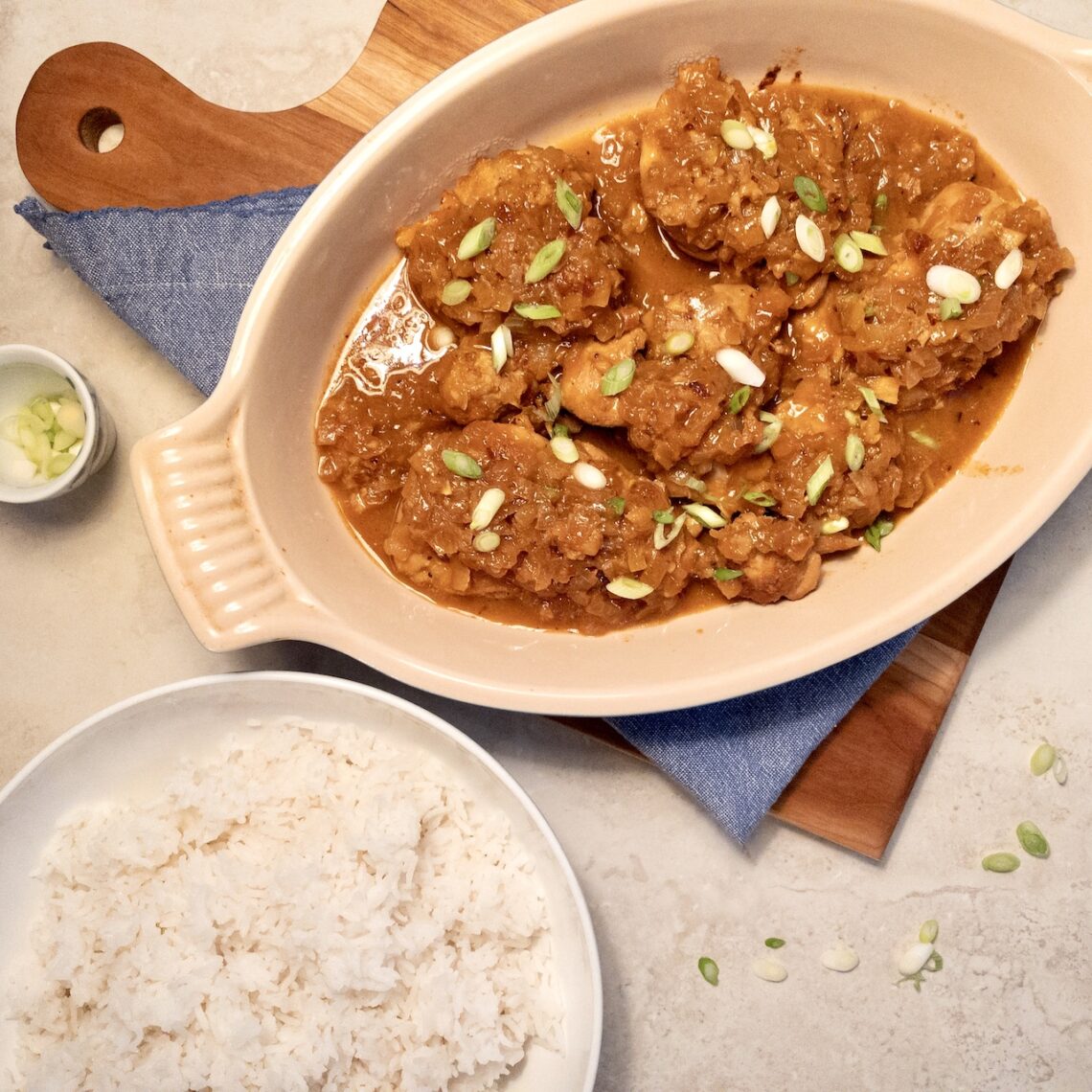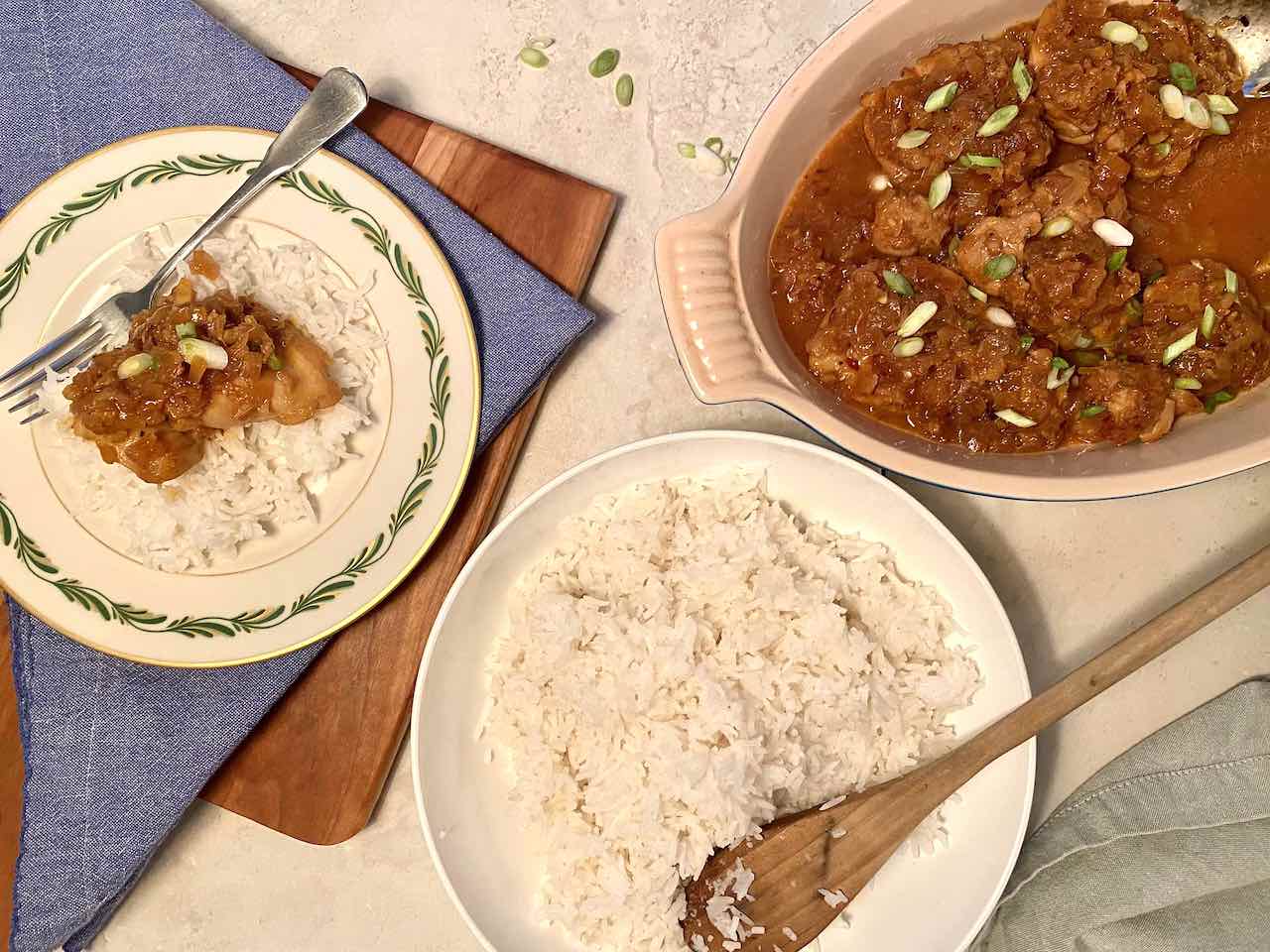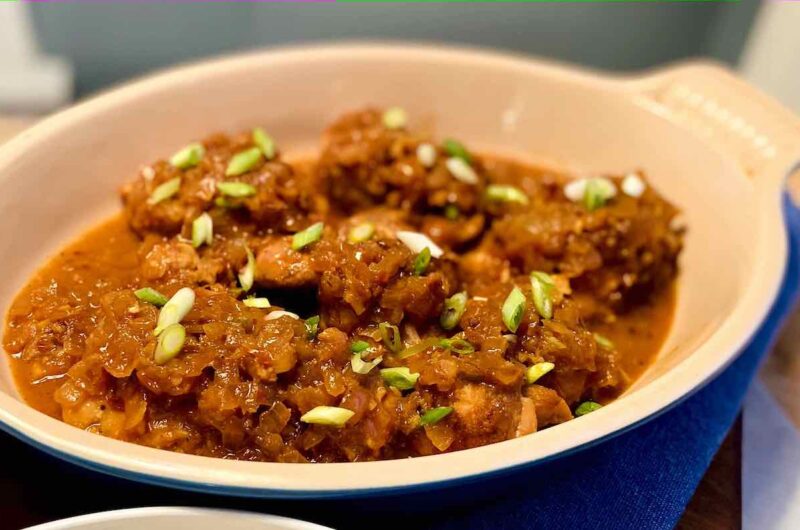
Dorie’s Sweet Chili Chicken Thighs
In 1946, the United States Department of Agriculture launched the “Chicken of Tomorrow” contest. The goal of the contest was to produce “one bird chunky enough for the whole family—a chicken with breast meat so thick you can carve it into steaks, with drumsticks that contain a minimum of bone buried in layers of juicy dark meat, all costing less instead of more.” Contestants had a year to breed and submit a chicken that fit this description.
This contest, thought up by the head of the largest supermarket chain of the time, the A&P, changed the trajectory of American chicken farming. Before the 1940s, chickens were often quite small and scrawny, with little meat on them. The fact that they laid eggs meant that chickens were often worth more alive than on the dining room table. Only when chickens were no longer able to lay eggs would a family eat them – and even then it was usually for a special occasion.
The Chicken of Tomorrow contest was a huge deal, involving state contests, then regional contests, and finally the national contest in 1948. The contest created two important chicken breeds: the Arbor Acres White Rocks’ white feathered birds, which won the purebred contest, and the Red Cornish crosses from the Vantress Hatchery. In later years, these two breeds were crossed to create the Arbor Acre breed, which now dominates poultry farms. (According to one source, in 2013 over half the chickens in China were related to the Arbor Acre chicken.)
Since the Chicken of Tomorrow contest, chickens have become larger and cheaper, and chicken consumption in the US has increased significantly. Chickens are bred to grow a lot bigger a lot faster. In the 1960s an average chicken was slaughtered when it was 65 days old and weighed about 3.5 pounds; today an average chicken is slaughtered at 47 days when it already weighs about 6 pounds. At the same time, Americans have gone from eating 28 pounds per person in 1960 to eating almost 94 pounds per person in 2018. This pattern holds true around the world, with global consumption increasing 31 percent between 2000 and 2011.
In the late 1940s, the increase in chicken consumption may have appeared to be a good thing. Yet today we know that how we raise these descendants of the Chicken of Tomorrow contest has a real impact on the environment. The waste from chickens – manure, feathers, spilled feed, carcasses – is often piled up near chicken houses, creating a terrible smell for anyone living nearby. Although the waste is often used to fertilize crops, the amount of waste is so large that some of it runs off into waterways, which can contaminate the water and even cause algae blooms.
Additionally, raising chickens creates a lot of greenhouse gas emissions. Chickens require a lot of feed, which means that vast amounts of land are being used to grow the chicken feed. This is inefficient, since the feed has to be grown, transported, and eaten by the chicken before the chicken becomes food for humans. If we grew food on that same land and ate it instead of using it to grow chicken feed, we would decrease emissions.
Although chickens don’t produce as many greenhouse gases as pork or beef, that’s a pretty low bar. Eating chicken instead of pork and beef is better – but not that much better – for the environment. And it’s certainly worse than eating less meat and more plant-based food. After all, the greenhouse gas emissions from one serving of chicken are eleven times higher than the emissions from a serving of beans. Sadly, buying organic meat won’t make much of a difference since a recent study found organic chicken is actually worse for the planet than conventional chicken.
While I don’t plan on becoming vegetarian any time soon, learning more about supply chains has made me decrease the amount of meat I eat. I’m fairly picky about meat, so it has to be really good to be worth it. This chicken dish, from the cookbook Everyday Dorie, is that good. (It’s covered in Thai sweet chili sauce, so there’s no way it would not be good.) The chicken was an instant hit, and it’s simple to make: combine a lot of strong (i.e. delicious) flavors in a large part with chicken thighs and let them do their thing. Come back half an hour later and enjoy the tender thighs with this sweet and spicy sauce over some rice.
To end, I want to (again) acknowledge that there is something incongruous about talking about the environmental impacts of poultry farming and then providing a recipe for chicken. But unlike some of the other ingredients I’ve covered, in one sense meat is easy to avoid – just don’t eat it. That’s a much easier step to take (at least conceptually) than avoiding all products produced with bad labor conditions, which would disqualify just about all the fruits and vegetables in the grocery store. While I (and likely most people) will continue to eat chicken, it’s important that we know where our food comes from and what the impact of eating it is. Only then can we work to increase regulations and change how food is produced.
If you’d like to learn more about the Chicken of Tomorrow contest, check out this article in National Geographic. To learn more about the chicken industry, check out the Rotten episode called “Big Bird” in Season 1.
Sweet Chili Chicken Thighs
Course: Dinner, Recipe4
servings50
minutesAdapted (barely) from Sweet Chili Chicken Thighs in Dories Greenspan’s wonderful cookbook, Everyday Dorie.
Ingredients
2 tablespoons canola oil (or other neutral oil), divided
1 medium onion, finely chopped
2 garlic cloves, finely minced
3 teaspoons ginger (or less to taste), finely minced
Sea salt
¼ cup white wine
5-8 chicken thighs, with/without skin, bone-in or boneless (I prefer skin-on and bone-in, but any kind will do)
Ground pepper
½ cup Thai sweet chili sauce
1/3 cup soy sauce
2 tablespoons of Dijon mustard
1 teaspoon Sriracha (or more to taste)
3 scallions, sliced, to garnish
Directions
- Chop and rinse the onions. Put them under cold water for 20 seconds, then pat dry.
- Heat 1 tablespoon of oil in a Dutch oven or large skillet over medium heat. Add the onion, garlic, ginger, a pinch of sea salt, and heat for about 5 minutes, until the onions are turning translucent. The onions should be soft but not browned.
- Add the white wine and cook until the wine evaporates, about 2 minutes. You may need to increase the heat a little bit. Remove the onions from the pan and set aside in a bowl.
- Heat one tablespoon of oil in the same Dutch oven over medium heat. Add the chicken and brown on both sides. Depending on how many chicken thighs you have, you may need to do this in batches.
- When the chicken thighs are browned, remove any excess oil from the pot. (Be careful doing this.) If the chicken has stuck to the bottom of the pan, scrape it off as best you can. (You can remove the chicken from the pot if you need to.)
- While the chicken thighs are browning, whisk together the Thai sweet chili sauce, soy sauce, Dijon mustard, and Sriracha.
- If you have removed the chicken from the pan, add it back in. Then add the onions and sauce to the pan and stir, making sure that everything is blended together and coated.
- Turn the heat to low, cover the pot, and cook for 30 minutes, basting the chicken every ten minutes.
- Sprinkle with green onions and serve over rice.






